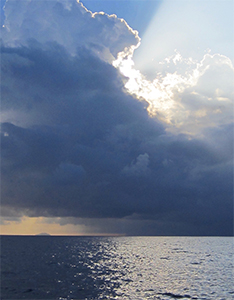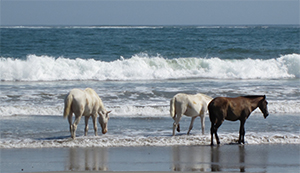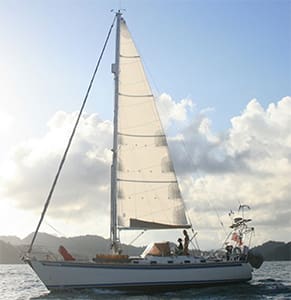To the editor: In our seven years of cruising, we have always been moving forward. On to the next anchorage, the next country or the next ocean. We’ve been smart in our weather window timings and lucky in our choices. But once, and only once in our sailing so far, we turned tail and retraced our watery wake for several hours. Why? Because sometimes the most sailorly course of action is to be a bit of a coward.
Years ago, we were sailing up the Pacific coast of Costa Rica. We were watching the weather for the local “gap winds” named after the Gulf of Papagayo, which lies near the border with Nicaragua and is where their force is most clearly felt. The effect occurs when high pressure systems move into the Caribbean, reinforcing the trade winds, which then sweep over Central America. The intensity depends on the power of the background wind and topography of the coastline. Papagayo winds are unusually gusty and turn on and off in an instant, producing blasts of double the normal wind strength, making you heel suddenly without warning.
 |
|
Dramatic skies signify a change in the weather. |
|
Jess Lloyd-Mostyn |
It was early March, approaching the end of Papagayo season, and we were pottering northward. Our plan was not actually to cross the gulf itself on this trip but to arrive and anchor in a nearby bay for a few days, waiting for perfectly calm conditions before crossing the notorious stretch of water with relative ease in as short a hop as we could manage. The forecast for the day in the Papagayo was for around 20 knots — quite manageable if we were to skirt the edge of it.
So far, the passage had been uneventful and all spent under engine as the wind was always less than 5 knots. Just then, still well south of the forecast wind zone, we saw a distinct gust line in the water, marking where the breeze increased starkly from a lazy lolloping 3 knots to a punchy and wild 25 knots in an instant. Quickly, we turned in order to change our sail plan while in milder conditions. We set up with caution, putting three reefs in the main and swapping our genoa for our staysail, as we wanted to be ready for the wind being even stronger than the gusts we’d just seen.
With nicely reduced canvas we headed back toward the wind line, prepared for a brisk run of 20 to 25 knots all the way up into the bay. But, less than an hour into our headway northward, we were consistently getting a base wind of 35 knots. It was already nighttime and, disturbingly, we were still several miles shy of the cape that marks the southernmost point at which the Papagayos can be felt.
Now, 35 knots is nothing dangerous. It counts as gale force but, properly reefed, the boat is still maneuverable and can be kept to course well. We’ve been in stronger winds in storm conditions and at least this time there was no rain. However, 35 knots is also not that fun when it’s dark and you’re standing solo watches. It meant that with every mile of progress we made forward, the wind was more likely to increase to 40 or 45 knots, which is the sort of wind that puts more stress on everything on board — not least of all the crew.
 |
|
Wild horses on a Costa Rican beach. |
|
Jess Lloyd-Mostyn |
One thing that makes any decision easier for us in such situations is to remember that even though we are passagemaking, eating up some serious mileage to get somewhere, we are also doing all of our cruising for pleasure. Ultimately, we are choosing to sail for its experiential value, and neither of us could see anything positive likely to come out of the night that we had ahead of us.
So we turned back. For the first and only time in our journeys to date, we decided that even though we would need to sail back for another 20 miles to get to the nearest viable anchorage, it would be well worth it on balance. We could tackle the big bad Papagayo on another day, preferably in the light and when we were well rested. By dawn we pulled into a tiny sheltered bay where we were greeted by the sight of wild horses running on the beach, a happy and dramatic contrast from the night we’d just had. We soaked in the view, dropped the hook and flopped gratefully into our bed, sleeping soundly in the knowledge that sometimes it’s okay to be a little bit chicken.
—Jess Lloyd-Mostyn and James left England aboard Adamastor, a Crossbow 42, intending to circumnavigate in just a couple of years. Seven years later, they are still sailing and have had two children en route, daughter Rocket in Mexico and son Indigo in New Zealand, and are shortly to welcome a third. They have covered more than 25,000 miles, crossed two oceans and visited 36 countries since they set off. They are currently in Indonesia and you can follow their progress at www.water-log.com.

